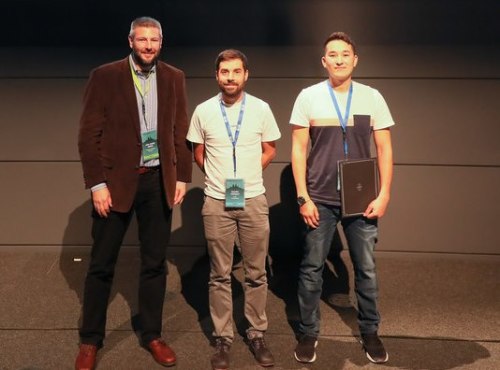Poster award for HZB PhD student

John Uhlrich, Editor-in-Chief at Wiley VCH presented an award to Quentin Jeangros, EPFL, and Eike Köhnen, HZB, for their outstanding posters (from left to right). © Gruppe Steve Albrecht/HZB
Eike Köhnen received an award for his poster on perovskite silicon tandem cells at the 4th International Conference on Perovskite Solar Cells and Optoelectronics (PSCO) in Lausanne, Switzerland. He is a PhD student in the Junior Research Group on Perovskite Tandem Cells led by Dr. Steve Albrecht.
Tandem cells made of organometallic perovskite layers and silicon have the potential for very high efficiencies. While perovskites in particular convert blue parts of the light spectrum into electrical energy, silicon uses the red parts of the light. Eike Köhnen is working on the design of a so-called monolithic tandem cell.
For his poster, which he presented at the 4th International Conference on Perovskite Solar Cells and Optoelectronics (PSCO) in Lausanne, Switzerland, he received an award sponsored by Wiley Science Publishers.
Köhnen has realized a highly efficient monolithic tandem solar cell with an efficiency of 25 percent, which has also been certified by independent bodies. The tandem cell was manufactured at HZB, the silicon cell being produced at HZB-Institute PVcomB and the perovskite cell at HySPRINT. By optimizing the optical and electrical properties of the tandem-top contact, it was even possible to achieve an efficiency of 26 percent, which is the highest efficiency currently published in the literature for this tandem architecture. Since the spectrum arriving on Earth changes over the course of the day, Köhnen also investigated the influence of the spectrum on the behavior of the tandem solar cell.
arö
https://www.helmholtz-berlin.de/pubbin/news_seite?nid=14951;sprache=en
- Copy link
-
Optical innovations for solar modules - which are the most promising?
In 2023, photovoltaic systems generated more than 5% of the world’s electrical energy and the installed capacity doubles every two to three years. Optical technologies can further increase the efficiency of solar modules and open up new applications, such as coloured solar modules for facades. Now, 27 experts provide a comprehensive overview of the state of research and assess the most promising innovations. The report, which is also of interest to stakeholders in funding and science management, was coordinated by HZB scientists Prof. Christiane Becker and Dr. Klaus Jäger.
-
Samira Aden joins ETIP PV - The European Technology & Innovation Platform for Photovoltaics ESG Working Group
Samira Jama Aden, Architect Design Research, has joined the ETIP PV - The European Technology & Innovation Platform for Photovoltaics working group “Environmental, Social and Governance (ESG)”.
-
The future of energy: recommendations from science to politics
Experts from HZB have contributed their expertise to the position papers briefly presented here. The topics include the development of innovative materials for a sustainable energy supply and the circular economy. Experts from different areas have jointly formulated solutions and recommendations for action.
